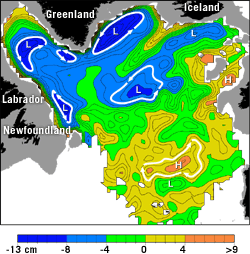 |
Science Highlights > Float Data Reveals Complex Circulation
Float Data Reveal Complex Circulation
 |

Click to enlarge
|
|
A map of large-scale ocean circulation at 700 meters (2,300 feet) from analysis of float trajectories plotted in the cover figure. Flow is shown as pressure contours, analogous to a weather map. In such maps, flow (of water or air) is along the contours, and tightly packed contours indicate higher speeds. Float trajectories did not measure predicted clear southward flow along the western boundary, but instead revealed an unexpected series of recirculations, which appear as counterclockwise flow around low pressure (L) centers. (Illustration by Kara Lavender) |
Sophisticated descendants of message-in-a-bottle drifters are changing our picture of North Atlantic circulation and how it may impact global climate. Working with colleagues from the US and several other countries, WHOI researchers launched an armada of drifting instruments and used their data to directly measure deep ocean currents in the northern North Atlantic Ocean.
This regional circulation strongly influences global climate. Warm subtropical surface waters flow toward high latitudes where, according to simple circulation models, they cool (becoming denser), sink, and return south in deeper currents. Satellite data offer a broad picture of the surface motion, but subsurface float coverage has only recently been extensive enough to map deeper flow over large areas. The colorful figure on the front cover shows trajectories from 211 floats traveling at three depths in the northern North Atlantic between 1994 and 2002. The accompanying map of the circulation (right) deduced from these data reveals unanticipated and complex deep flow, including boundary current recirculations at 700 meters (2,300 feet), significant flow into the North Atlantic Current, and little evidence of the predicted southward-flowing deep western boundary current. Institution scientists involved in these studies include physical oceanographers Kara Lavender and Brechner Owens.
Amy Bower and Phil Richardson, also of the Physical Oceanography Department, participated in float work in the Northeast Atlantic that details how warm, saline water from the Mediterranean Sea reaches high latitudes, where it is important in dense water formation. They also found that currents crossing over the Mid-Atlantic Ridge are nearly locked in place over deep, narrow gaps in the ridge, an effect that may have implications for the ocean’s response to climate change.
US funding for this research was provided by the National Science Foundation, the Office of Naval Research, and the National Oceanic and Atmospheric Administration.
|
